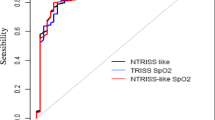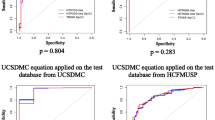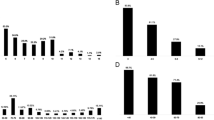Abstract
Background
The objective of the present study was to identify logistic regression models with better survival prediction than the Trauma and Injury Severity Score (TRISS) method in assessing blunt trauma (BT) victims in Japan and Thailand. An additional aim was to demonstrate the feasibility of probability of survival (Ps) estimation without respiratory rate (RR) on admission, which is often missing or unreliable in Asian countries.
Methods
We used BT patient data (n = 15,524) registered in the Japan Trauma Data Bank (JTDB, 2005–2008). We also extracted data on BT patients injured in the Khon Kaen District between January 2005 and December 2008 (n = 6,411) from the Khon Kaen Hospital Trauma Registry. For logistic regression analyses, we chose the Injury Severity Score (ISS), age year (AY), Glasgow Coma Scale (GCS) score, systolic blood pressure (SBP), RR, and their coded values (c) as explanatory variables, as well as the Revised Trauma Score (RTS). We estimated parameters by the method of maximum likelihood estimation, and utilized Akaike’s Information Criterion (AIC), the area under the receiver operating characteristic curve (AUROCC), and accuracy for model comparison. A model having the lower AIC is considered to be the better model.
Results
The AIC of the model using AY was lower than that of the model using the coded value for AY (cAY) (used by the TRISS method). The model using ISS, AY and cGCS, cSBP, and cRR instead of the RTS demonstrated the lowest AIC in both data groups. The same trend could be observed in the AUROCCs and the accuracies. In the Khon Kaen data, we found no additional reduction of the AIC in the model using the cRR variable compared to the model without cRR.
Conclusions
For better prediction of Ps, the actual number of the AY should be used as an explanatory variable instead of the coded value (used by the TRISS method). The logistic regression model using the ISS, AY, and coded values of SBP, GCS, and RR estimates the best prediction. Information about RR seems to be unimportant for survival prediction in BT victims in Asian countries.
Similar content being viewed by others
References
Boyd CR, Tolson MA, Copes WS (1987) Evaluating trauma care: the TRISS method. Trauma Score and the Injury Severity Score. J Trauma 27:370–378
Champion HR, Sacco WJ, Copes WS et al (1995) Injury Severity Scoring again. J Trauma 38:94–95
Baker SP, O’Neill B, Haddon W et al (1974) The Injury Severity Score: a method for describing patients with multiple injuries and evaluating emergency care. J Trauma 14:187–196
Champion HR, Sacco WJ, Copes WS et al (1989) A revision of the Trauma Score. J Trauma 29:623–629
Association for the Advancement of Automotive Medicine (1998) The Abbreviated Injury Scale: 1990 Revision, updated 1998. Des Plaines, IL
American Association for Automotive Medicine (1985) The Abbreviated Injury Scale 1985 Revision. Arlington Heights, IL
Kimura A (2010) Logistic regression models for Japanese blunt trauma victims. J Jpn Assoc Surg Trauma 24:15–20
Japan Trauma Data Bank Report 2005–2009. http://www.jtcr-jatec.org/traumabank/dataroom/data/JTDB2005-09e.pdf. Accessed 10 Sep 2011
Akaike H (1974) A new look at the statistical model identification. IEEE Trans Automat Contr 19:716–723
Schluter PJ, Nathens A, Neal ML et al (2010) Trauma and Injury Severity Score (TRISS) coefficients 2009 revision. J Trauma 68:761–770
Fujita T, Morimura N, Uchida Y et al (2010) M-study from urban trauma center in Tokyo. J Trauma 69:934–937
Bouamra O, Wrotchford A, Hollis S et al (2006) A new approach to outcome prediction in trauma: a comparison with the TRISS model. J Trauma 61:701–710
Nakahara S, Ichikawa M, Kimura A (2011) Simplified alternative to the TRISS method for resource-constrained settings. World J Surg 35:512–519
Tohira H, Matsuoka T, Watanabe H et al (2011) Characteristics of missing data of the Japan Trauma Data Bank. JJAAM 22:147–155
Association for the Advancement of Automotive Medicine (2008) The Abbreviated Injury Scale 2005 update 2008. Barrington, IL
Acknowledgments
The authors are grateful to all the people who have been involved with the Japan Trauma Data Bank, and those who have been engaged in the Trauma Registry at the Trauma and Critical Care Center of Khon Kaen Regional Hospital in Thailand. This work was supported by a Health and Labour Sciences Research Grant for Research on Global Health Issues from the Ministry of Health, Labour and Welfare of Japan.
Conflict of interest
None.
Author information
Authors and Affiliations
Corresponding author
Rights and permissions
About this article
Cite this article
Kimura, A., Chadbunchachai, W. & Nakahara, S. Modification of the Trauma and Injury Severity Score (TRISS) Method Provides Better Survival Prediction in Asian Blunt Trauma Victims. World J Surg 36, 813–818 (2012). https://doi.org/10.1007/s00268-012-1498-z
Published:
Issue Date:
DOI: https://doi.org/10.1007/s00268-012-1498-z




